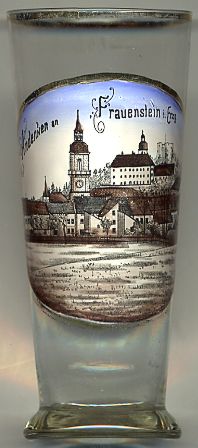

|
| DEUTSCHLAND | GERMANY |
| Bundesland: Freistaat Sachsen | Saxony |
| Landkreis: Mittelsachsen |
 Frauenstein is situated at an elevation of 650 m in the eastern part of the Erzgebirge / Vogtland
nature reserve, about 20 southeast of Freiberg and 30 km southwest of
Dresden. The municipality has a population of about 3,200 (2007); besides Frauenstein proper, the
municipality also includes the municipal districts Burkersdorf, Dittersbach, Nassau and Kleinbobritzsch.
Frauenstein is situated at an elevation of 650 m in the eastern part of the Erzgebirge / Vogtland
nature reserve, about 20 southeast of Freiberg and 30 km southwest of
Dresden. The municipality has a population of about 3,200 (2007); besides Frauenstein proper, the
municipality also includes the municipal districts Burkersdorf, Dittersbach, Nassau and Kleinbobritzsch.
Around 1200 a stronghold was founded on a hilltop. Soon after that, silver ore was found nearby. This led to the foundation of a miners' settlement which, however, was abandoned after 1470 due to its unfavourable location in an inundable place. A new settlement was then founded on an elevated plateau in the vicinity of the castle. The earliest written document mentioning Vrounsten dates from 1218. Later documents mention the place as Vrowenstein (1272), Vrouwenstein (1321), Vrowinstein (1385), Frauwinstein (1405), Frawenstein (1424) and Ffrauwenstein (1439). The name most likely is derived from the Middle High German word 'vrowe', which means a lady, and probably refers to the castle's chapel which was dedicated to Our Lady. The castle served as one of a number of strongholds protecting the border of the margraviate of Meißen against Bohemia. In addition it protected the important trading route from Freiberg to Teplice. In 1411 Frauenstein was chartered as a town. The castle was destroyed by a great fire in 1728. It is the largest castle ruin in Saxony. In the 20th century, the neighbouring communities of Kleinbobritzsch (1974) and Burkersdorf, Dittersbach and Nassau (unrelated to Nassau in Rhineland-Palatinate) (1994) were incorporated into the municipality.
 Frauenstein castle [background right] was built in 1585–1588 in
Renaissance style next to the old castle because the old castle could not provide enough comfort. The old castle was
destroyed in 1728 by a great fire which also destroyed large parts of the town. Frauenstein castle was in possession of the
margraves of Meißen, later electors of Saxony. A number of noble families were given the
castle as a fief in the ensuing centuries. In 1647 it returned into the possession of the Saxon Electors and since then was
used as the local county administration. In 1873 the seat of the administration was finally moved to
Dippoldiswalde. In 1983 a museum for the famous organ-builder Gottfried Silbermann
(1683–1753), who was born in Kleinbobritzsch, was installed in the castle.
Frauenstein castle [background right] was built in 1585–1588 in
Renaissance style next to the old castle because the old castle could not provide enough comfort. The old castle was
destroyed in 1728 by a great fire which also destroyed large parts of the town. Frauenstein castle was in possession of the
margraves of Meißen, later electors of Saxony. A number of noble families were given the
castle as a fief in the ensuing centuries. In 1647 it returned into the possession of the Saxon Electors and since then was
used as the local county administration. In 1873 the seat of the administration was finally moved to
Dippoldiswalde. In 1983 a museum for the famous organ-builder Gottfried Silbermann
(1683–1753), who was born in Kleinbobritzsch, was installed in the castle.
The  town church [centre], built around 1800, is well-known for its organ,
built in 1873 by Richard Kreutzbach. Two prior organs were built by Gottfried Silbermann in 1711 and 1738, but both of them
were destroyed by the great fires in 1728 and 1869, respectively. The Kreutzbach organ was restored in 2008.
town church [centre], built around 1800, is well-known for its organ,
built in 1873 by Richard Kreutzbach. Two prior organs were built by Gottfried Silbermann in 1711 and 1738, but both of them
were destroyed by the great fires in 1728 and 1869, respectively. The Kreutzbach organ was restored in 2008.
![[scale]](lineal.jpg)